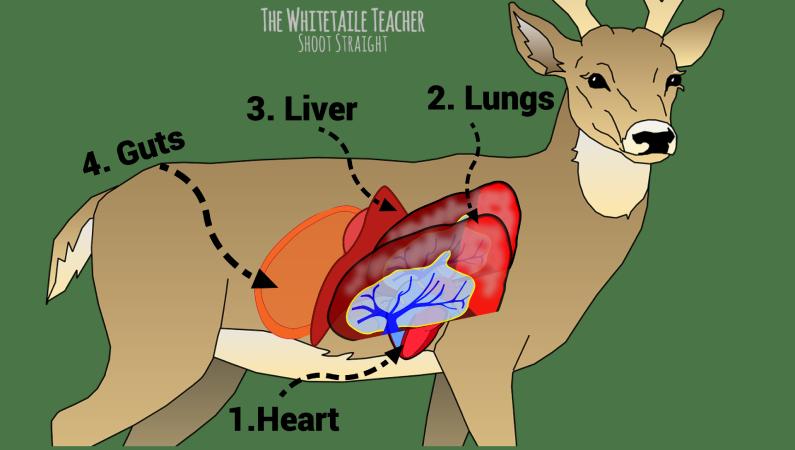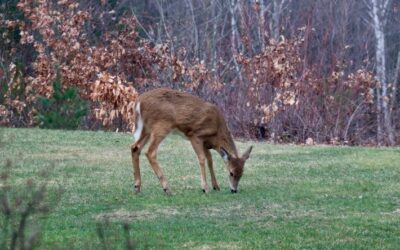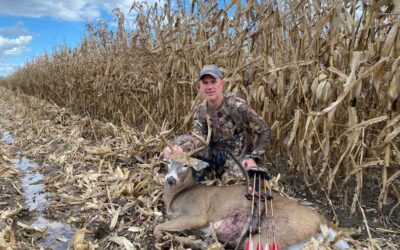This article may contain affiliate product links. I may receive a commission from sales. However, there is no extra cost to the buyer for using my affiliate link.
Using my affiliate links help support The Whitetail Teacher and allow me to deliver more content to help you become a better whitetail deer hunter.
Although knowing the deer anatomy to properly aim and ensure a lethal shot on a deer is important, the entire deer anatomy is essential to understanding how whitetail deer act in nature.
Where to aim for a lethal shot is the most essential reason we learn the deer anatomy; however, the other parts of the anatomy are what separate the ‘good’ hunters from the ‘great’ hunters.
We all want to be great hunters.
Lethal shots
A Lethal shot is any shot that can kill a whitetail deer with one shot.
The success rate of these types of shots is near 100%.
Occasionally a deer will be abnormally resilient to a good but not great shot, and you may need to give the deer some extra time to expire even if you place a good shot.
1. Heart Shot
The heart is what we like to call ‘the pump house’. It is the best shot that you can make on a deer.
The heart is located right behind the shoulder bone and slightly to the left or right of where the leg meets the body. It is also placed right between the two lungs.
Although the heart is the best spot to shoot a deer, it is not always the most probable spot to put your cross heirs or archery pin.
You want to ensure a lethal shot and when you aim just at the heart you run the risk of even a slightly low shot not hitting its target. Or even worse, your arrow hits the shoulder blade and gets no penetration.
If you are using a gun, you should have no problems with hitting the shoulder bone. But you still could miss low due to human error.
A heart shot on a deer is extremely difficult with a bow or a gun and it should be noted is not the best place to aim.
2. Lungs Shot
Lungs have the biggest surface area that will ensure a lethal shot.
Every deer has two lungs.
The lungs overlap one another and when a shot goes through both lungs of a deer it is called a ‘double lung’ shot. Pretty self-explanatory as to why is it called that.
The lungs of a deer are by far the safest way to ensure a lethal shot with any weapon of your choosing. They have plenty of surface area. The blood trails are full of blood and tend to be short.
But where should you aim in the lungs?
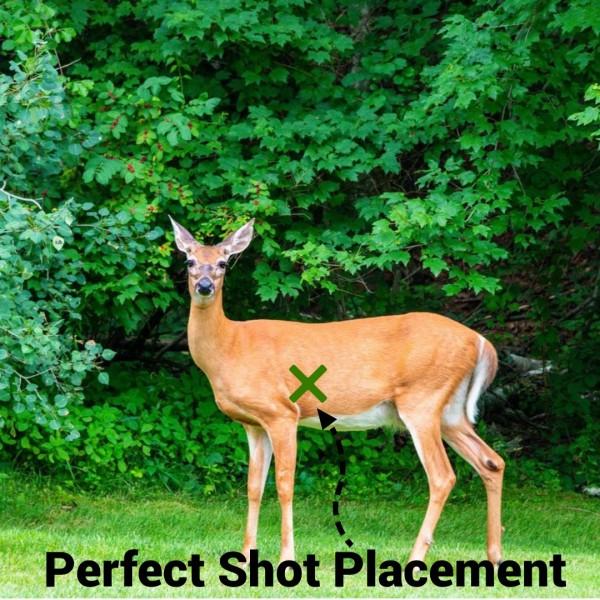 I think it is best to put your pins or cross heirs right where the top of the heart meets the lungs. Look to see exactly where that is on the deer anatomy diagram. As they say, “X marks the spot! Practice with your bow aiming right at that spot on your deer target or while sighting your gun in. Get really accurate doing this to ensure a lethal shot every time!
I think it is best to put your pins or cross heirs right where the top of the heart meets the lungs. Look to see exactly where that is on the deer anatomy diagram. As they say, “X marks the spot! Practice with your bow aiming right at that spot on your deer target or while sighting your gun in. Get really accurate doing this to ensure a lethal shot every time!
3. Liver Shot
When talking about making a lethal shot on a whitetail deer, the liver is by far the trickiest part of the body.
The liver is supposedly a lethal shot. I agree that a liver shot will make a deer take a dirt nap. However, the liver is by no means a place you want to aim.
It is way too close to the deer’s stomach to be risking your shot being a little off the target towards the back. If you were to hit the deer’s stomach, it is likely that the deer will survive this shot. Even if the deer does die from a gutshot, it will be a long and dreadful tracking process.
4. The Shoulder/Scapula Shot (Gun Hunters Only)
The shoulder shot is a lethal shot. However, arrows will most likely not be able to penetrate a deer’s shoulder bone.
If you are gun hunting though, then a bullet will have no problem breaking that scapula bone and making it nearly impossible for the deer to walk. Also, your bullet will break into the lungs or even the heart after shattering the shoulder bone.
This shot with a gun will most likely drop the deer in its tracks. No blood trail.
5. Spine Shot
The Spine of a deer is in the center of the nervous system. It will without a doubt kill a deer.
However, you do not want to aim for the spine because you have a much higher chance of missing the whitetail over the back.
6. Neck Shot
The neck shot is a shot that is obviously not advised because of the level of difficulty to aim.
Not only are deer constantly moving their heads up and down, but the windpipe is also exactly where you would need to puncture the deer’s neck to ensure a kill shot.
The windpipe is located on the bottom of the neck and is just a small tube that allows the deer to breathe.
If something went terribly wrong and you shot a deer in the neck you would most likely be able to find that deer. It is just not the best or recommended place to aim your weapon.
7. Head Shot
The brain of a deer is by far a great way to stop a deer in its tracks. HOWEVER, this is not what you want to aim for.
The first reason the head is not a good shot is because of the antlers on a buck. You do not want to break or damage the antlers of any buck and ruin your mount.
Secondly, if you aim for the head, it is likely that you will miss or even worse just wound the animal and make it impossible for the deer to eat. If that were to happen, the deer would die but not until days later.
As hunters and outdoorsmen, we want to be respectful of the game we hunt and cause the least amount of suffering possible.
Non-Lethal Shots
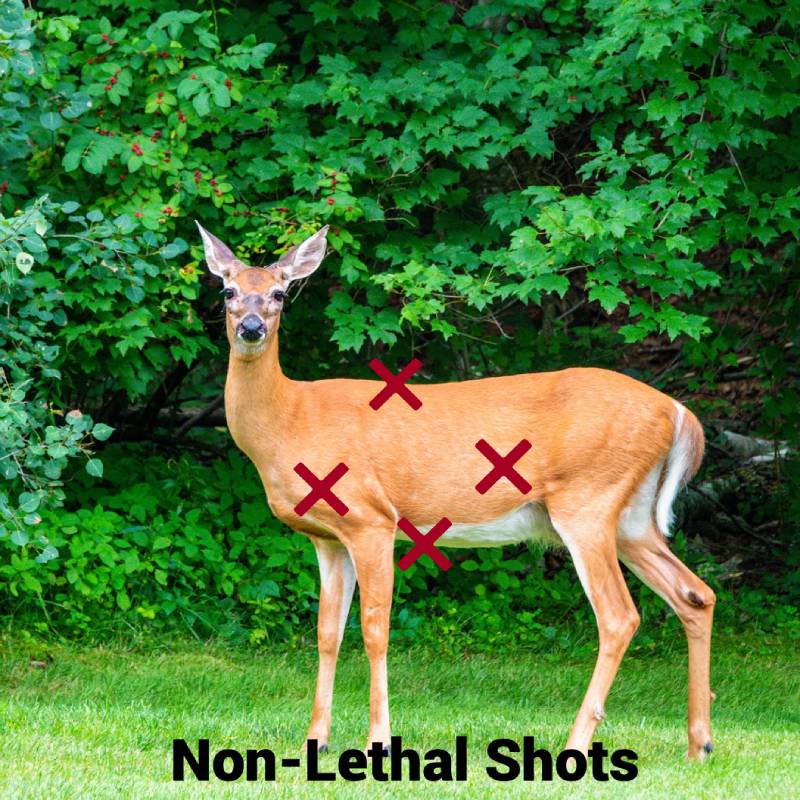 A non-lethal shot is any shot that will not kill a deer in a reasonable time frame. All these shots are prime examples of non-lethal shots.
A non-lethal shot is any shot that will not kill a deer in a reasonable time frame. All these shots are prime examples of non-lethal shots.
1. Guts Shot
The gut of a deer is the most unfavorable shot that you can make on a whitetail deer.
A gutshot has the highest likely hood of survival except for a graze, or complete miss. This shot does happen and of course, we want to avoid it at all costs.
If you do end up shooting a whitetail deer in the guts, it will be a long process of trying to track, not bump, and retrieve the deer. In some cases, you will be able to get another shot that should be more lethal. However, a gutshot can also result in a wounded deer that will survive or die many days later.
2. Shoulder Shot (bow)
I talked a little bit about the shoulder bone in the lethal shots section above. However, that was specific to gun hunting.
When bow hunting, a shoulder or scapula shot will most likely not be able to break through that bone. Therefore, it is so hard to shoot a deer quartering towards you with a bow.
If you do shoot a deer in the shoulder with a bow. It is likely that your arrow will not penetrate and will fall out of the deer quickly as he runs away.
3. Any Shot you Skim the Deer
If you skim the top or bottom of a deer with your shot, you will not be able to find that deer at all. It has survived.
You may find white hair and some very think squishy blood on the ground or on your arrow. It will be a small amount and you will know that you did not make a good enough shot.
What Different Blood Colors Mean
After every shot, there is a bloody arrow and/or a blood trail. It is important to analyze the type of blood to get a proper understanding of where you most likely hit your deer.
These different types of shots will be able to help you decide what type of shot you made, how long to wait before tracking, and how far to expect the deer to run before expiring.
1. Heart Shot Blood
Blood from a heart shot is a slightly darker shade of red and will be decently thick. Think of the blood that you see when you give blood at the hospital.
This is a great shot!
Expect the tracking time to be anywhere from 25-200 yards from the shot.
2. Lungs Shot Blood
Lung shots create blood that is brighter than any other shot. Another sign of a lung shot is that there will most likely be bubbles of air in the blood.
This is a great shot!
Expect a solid blood trail for 25-100 yards from the shot.
3. Liver Shot Blood
A liver shot will result in a dark red blood trail. You will want to wait at least three or more hours before trying to track the deer.
This is a lethal but not great shot.
If you do not jump the deer the track should be about 400-1000 yards from the shot.
If you have any doubts about your shot, just back out and come back after many hours have gone by.
4. Gut Shot Blood
A gutshot will result in a mixture of blood and digested food. The deer will most likely bed down to preserve energy.
You do not want to bump a wounded deer. It is best to treat this as a liver shot. Give the deer plenty of time before tracking.
This is not a good shot but could possibly be okay.
The blood trail should be quite long (600-1500 yards) if the deer even dies.
Maybe a good idea to stay prepared to make a follow-up shot if you can get close enough to the deer while it is bedded down.
5. A Skim Shot Bood
A skim shot will result in fat and blood. The blood will be thick, almost like a sponge. There is a good chance of white hair on the ground as well.
This is not a good shot.
No need to track that deer. It will survive most likely be unharmed as well.
Other Notable Deer Anatomy
The whitetail deer is an amazing animal that is equipped with many attributes that help them survive and thrive in nature. These attributes are some of the notable parts of a deer’s anatomy that will be helpful to you as a hunter.
1. Nose
The whitetail deer’s biggest advantage that they have over humans is their noses. Their ability to smell and pinpoint where that smell is coming from.
They have a significant amount of smelling tissue in their noses. They also lick their nose often to smell more efficiently.
The blowing sound that almost every hunter has experienced happens when deer cannot smell good enough, so they need to clear their abnormally large nostrils.
Therefore, Scent control is the biggest factor in a lot of whitetail hunting situations.
2. Eyes
The eyes of a whitetail deer are EVERYWHERE! At least that is what it seems like when you are hunting.
A whitetail deer’s eyes have 310 degrees of vision due to the position of their eyes on their head. Now you know why they always seem to see your movement.
Deer’s vision is best at dusk and at dawn and that is why they are the most active during those periods.
3. Ears
The Whitetail deer’s ears are one of the most important assets to a deer.
The ears of a deer are used to hear danger from a distance and check the wind. They also can rotate to get maximum value.
You want to use their ears to trick them by using grunt calls and rattling antlers. If you can master the sounds of a deer, you will become a more successful hunter without a doubt.
4. Deer Glands
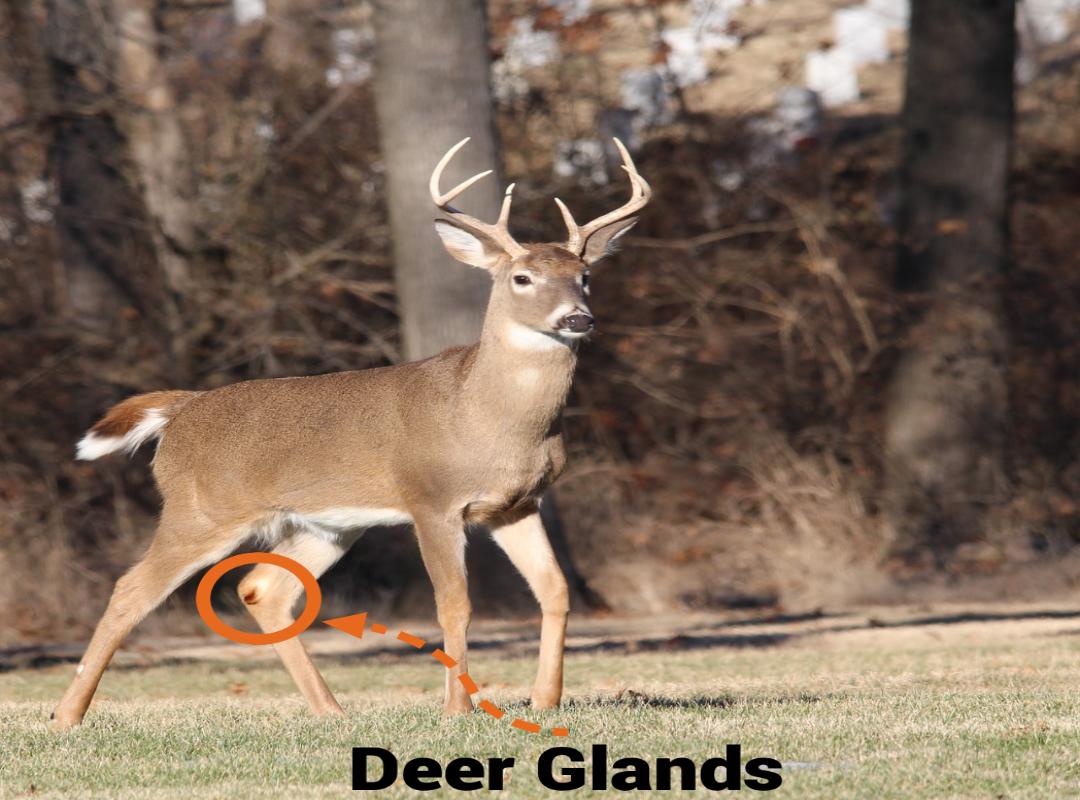
The glands on a whitetail deer are the dark circles on the back of their hind legs.
They are used to hold scents. Each gland and scent are unique to each buck.
Bucks use their tarsal glands to mark territories.
Does use their glands to let bucks know when they are in estrus and ready to breed.
These glands in both male and female deer are used to communicate with other deer in the area.
5. Antlers
Deer antlers are only on the male species of whitetail deer.
They are used to fighting and asserting dominance over other bucks.
Do not be fooled. Bigger antlers do not always mean the most dominant buck. Sometimes a dominant buck has a smaller rack but is just more aggressive than a larger racked buck.
6. Legs
Whitetail deer have some extremely powerful legs.
They can jump up at approximately a height of 8.2 ft and approximately a length of 29ft.
Their top speed is roughly 40 MPH… that’s insanely fast!
Three Ways a Deer Gives a Shot Opportunity
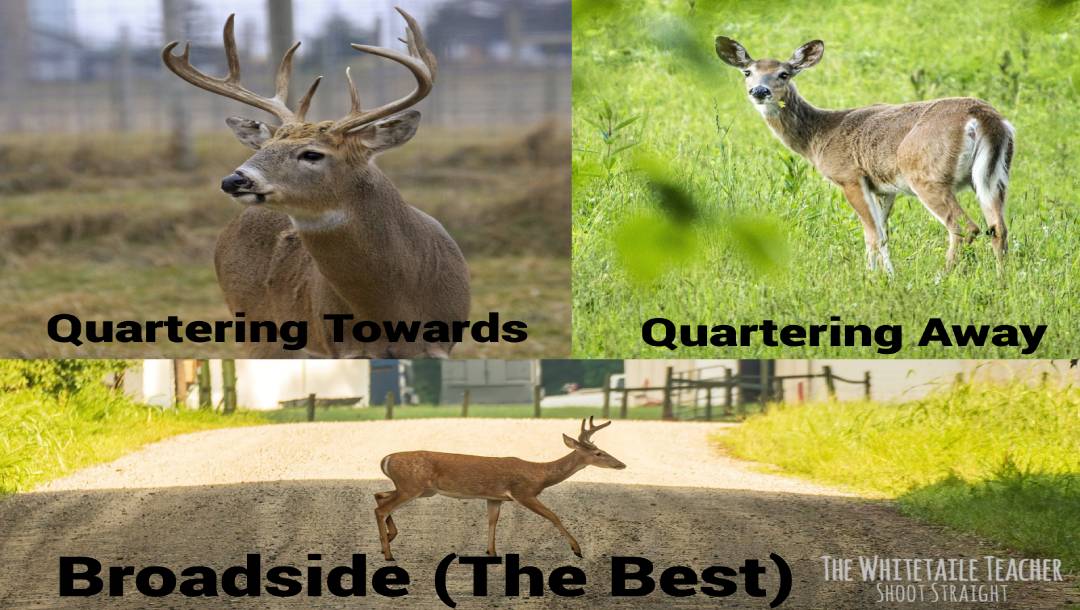
The three different ways a whitetail deer can give you a shot is useful to know because it affects where your shot placement should be.
This is also why it is essential to know the deer anatomy to get a better understanding of how you will need to execute your shot in the woods.
A. Broadside
A broadside deer’s body will be facing you perfectly towards you.
This will expose all the major arteries and give you a great chance of making a good shot that will be lethal.
Hunters, including myself, believe this is the best way for a deer to give you a shot opportunity.
B.Quartering Away
When a deer is quartering away, its head is farther from you than its tail.
This shot opportunity is great to put an arrow through a lot of lethal arteries.
The only downside is that you have a smaller place to shoot your arrow.
Also, make sure you shoot a little bit back to avoid a shoulder bone and do the most damage.
C. Quartering Towards
Quartering towards you is the hardest shot to make.
This is because when the deer is facing you, you have a small placement option, and it is hard to not hit the guts due to the line of your arrow or bullet.
I would recommend either waiting and hoping the deer turns or taking your shot and making sure you aim more towards the shoulder blade but without hitting the shoulder bone (if you are hunting with a bow).
Ensure a Lethal Shot
These three small tips are just reminders that should be in the back of your head while in the woods. It is tough to remember them all the time but they are effective in helping you fill a tag.
1. Steady Nerves
Make sure that you take a deep breath before you pull that trigger or release that arrow. It helps a ton in making sure there is no movement of your pin or cross heirs.
2. Pick a Hair
The saying, “aim small, miss small” is a very true statement.
I like to pick a single hair or small group of hairs and stay hyper-focused on that point. I will worry about how good of a shot it was later.
All that matters at that moment are focusing on where you want your sights to be.
3. Do Not Look at Antlers (once you decide to shoot)
One way that you can help to avoid buck fever is to just not look at the antlers.
You obviously want to make sure that the buck is a deer that is on your target list.
(I also don’t judge the brown its down mindset either)
But after you decide that you are going to pull the trigger, just focus on making a good lethal shot.
The anatomy of a deer is a great way to become more informed as a hunter. It is one of the best ways to plan a strategy for your hunts. I obviously did not cover every single topic; however, I did cover the essential parts.
I hope this post helped you learn more about deer anatomy and how to use this information to become a better whitetail deer hunter.
Thank you for visiting The Whitetail Teacher! If you enjoyed this post, make sure to share it with a friend.
If you have any questions or recommendations for new blog posts, please use the contact form.
Learn, Plan, Execute,
The Whitetail Teacher

